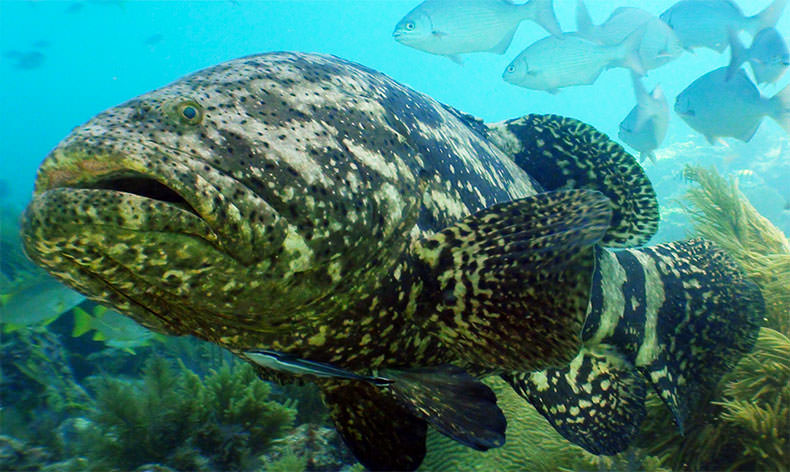
Concluding Remarks
This is the first attempt to comprehensively describe the status, pressures and trends of resources in the sanctuary. At its core, this document is an executive-level summary of research that describes the status and condition of sanctuary resources and should be used in conjunction with the more detailed summaries of the individual monitoring and research programs (e.g., zone monitoring program, water quality protection program, etc.). Additionally, this report helps identify strengths in current monitoring efforts, as well as causal factors that may require monitoring and potential remediation in the years to come. The data discussed will enable resource managers and stakeholders not only to acknowledge prior changes in resource status, but will provide guidance for future management challenges. For example, this report supports the need for additional management actions that address the degraded conditions of some key habitats and living resources in the sanctuary.
In this era of significant decline of coral reefs throughout the world, resilience is the key to survival of this critical ecosystem. It has been estimated that coral cover on reefs in the Caribbean has declined by an average of 80% in the last three decades (Gardner et al. 2003). It is generally agreed that these declines are not due to a single cause, but have resulted from multiple stressors acting together to alter ecosystem conditions and resulting in widespread deterioration. In turn, resource "managers may be able to increase the resilience of the system to climate change...by reducing impacts of local- and regional-scale stressors, such as fishing, input of nutrients, sedimentation and pollutants, and degraded water quality" (Keller et al. 2009). Many areas within the sanctuary, especially patch reefs and the deeper, fore-reef environment, continue to exhibit relatively high cover (>25%) by reef-building corals, and this may provide important insight in understanding resilience and other factors that sustain coral reef vitality. Therefore, it is more important than ever to protect remaining healthy reefs from impacts that can be addressed through management actions, both for their own sake and in order to help us promote the recovery of other coral reefs.
Because of the recreational and commercial importance of the marine resources of the Florida Keys, protecting these sanctuary resources is valuable not only for the environment but also for the economy. The special marine resources of the region, which led to the area's designation as a national marine sanctuary, contribute to the high quality of life for residents and visitors. Without these unique marine resources, the quality of both life and the economy of the Keys would decline.
Acknowledgments
The staff of Florida Keys National Marine Sanctuary would like to acknowledge the assistance and efforts of subject area experts who, by participating in meetings in March 2008, provided responses to questions that guided the drafting of the "State of Sanctuary Resources" section of this report: Alejandro Acosta (FWC), Lad Akins (REEF), Jerald Ault (UM-RSMAS), Erich Bartels (MML), James Bohnsack (NOAA Fisheries Service), Joseph Boyer (FIU), Joseph Cavanaugh (REEF), Leda Cunningham (REEF), Bob Glazer (FWC), John Hunt (FWC), G. Todd Kellison (NOAA Fisheries Service), Tom Matthews (FWC), Margaret Miller (NOAA Fisheries Service), Steven Miller (UNCW), and Cory Walter (MML). The authors would also like to recognize the extensive contributions of Mark Chiappone (UNCW) to this document.
The report benefited significantly from the following individuals who either provided a preliminary review of the report or contributed comments, content, images and data: Lad Akins (REEF), Jerry Ault (RSMAS), Carrie Backlund (Naval Air Station, Key West), Edward Barham (Naval Air Station, Key West), Rick Beaver (FWC), Cathy Becky (USGS Sirenia Project), Donald Behringer (UFL), Heather Blough (NOAA NMFS), Geoffrey Bock (Dept. of Primary Industries & Fisheries), Jim Bohnsack (NOAA NMFS), Theo Brainerd (NOAA NMFS), Mark Chiappone (UNCW), Gabriel Delgado (FWC), Michael Feeley (FWC), Roland Ferry (Wetlands, Coastal and Oceans Branch, EPA, Region 4), Megan Forbes (NOAA Marine Debris Program), Karen Fox (Clancy Environmental Consultants, Inc., a Tetra Tech Company), Todd Hitchins (NOAA), John Hunt (FWC), Bill Kiene (ONMS Southeast Region), William Kruczynski (Special Studies, EPA, Region 4), Gang Liu (NOAA Coral Reef Watch Program), Jerry Lorenz (Audubon Society), Margaret Miller (NMFS), Anne Morkill (FWS), Ken Nedimyer (Coral Restoration Foundation), David Polk (Florida Department of Health), Rob Ruzicka (FWC), Joe Schittone (formerly of ONMS), David A. Score (NOAA Corps), William Sharp (FWC), Tonya Shearer (Georgia Institute of Technology), Manoj Shivlani (RSMAS), and Ricardo Zambrano (FWC). Current and former staff of Florida Keys National Marine Sanctuary also provided preliminary reviews of the report or contributed comments, content, images and data: Brenda Altmeier, Jeff Anderson, Michael Buchman, Karrie Carnes, Joanne Delaney, Nancy Diersing, Kent Edwards, Alicia Farrer, Lilli Ferguson, William Goodwin, John Halas, Todd Hitchins, J. Harold Hudson, Robert Keeley, Lauri MacLaughlin, Sean Morton, William Precht, Benjamin Sniffen, Steve Werndli, and Fiona Wilmot. Finally, our sincere thanks are extended to the peer reviewers of this document: John F. Bruno, Ph.D. (Associate Professor, University of North Carolina at Chapel Hill), Richard E. Dodge, Ph.D. (Dean, Nova Southeastern University Oceanographic Center), Paul Sammarco, Ph.D. (Professor, Louisiana Universities Marine Consortium), and Rob van Woesik, Ph.D. (Professor, Florida Institute of Technology).

